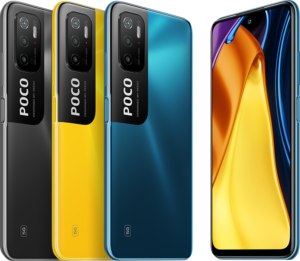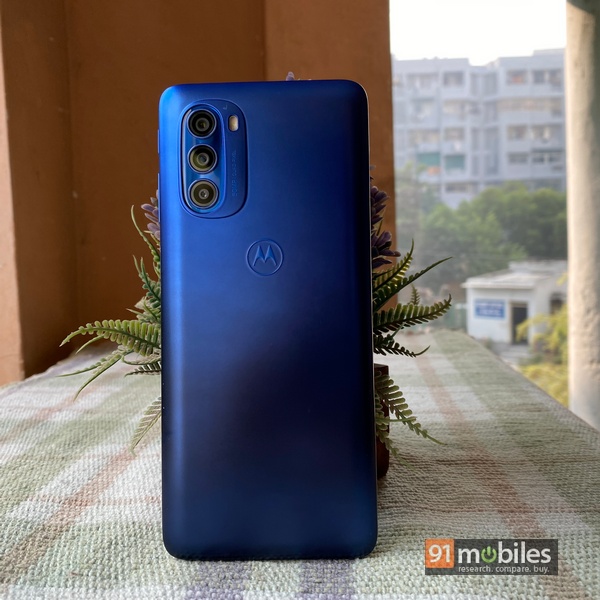
Motorola just launched Moto G51 5G, its newest budget offering, in the country. The phone happens to be the first smartphone in the country to be powered by Qualcomm’s Snapdragon 480+ 5G SoC. Apart from this, the highlighting feature here is the support for a total of 12 5G bands, which is the highest in a budget 5G smartphone. On paper, the Moto G51 5G seems to be a no-compromise 5G smartphone that is coming in hot at a price tag of Rs 14,999. The pricing puts it into the competition with the POCO M3 Pro 5G, a favourite of the buyers this festive season. So, how do these two phones compare? Let’s find out.
Moto G51 5G vs POCO M3 Pro 5G: price in India
| Model | Variant | Price |
| Moto G51 5G | 4GB + 64GB | Rs 14,999 |
| POCO M3 Pro 5G | 4GB + 64GB | Rs 14,499 |
| 6GB + 128GB | Rs 16,499 |
When it comes to pricing, the Moto G51 5G comes in just a single configuration, i.e. with 4GB RAM and 64GB storage. This model is priced at 14,999. There is no official word on the launch of a 6GB RAM variant for now.
On the other hand, the POCO M3 Pro 5G comes in with two variants. The entry-level option with 4GB RAM with 64GB storage is priced at Rs 14,499 as of writing this post. Its higher spec’d model with 6GB RAM and 128GB storage will cost you Rs 16,499.
Moto G51 5G vs POCO M3 Pro 5G: availability
Both the Moto G51 & POCO M3 Pro are available in the market via Flipkart. As of now, both brands are going for online-only sales model, which has been paying off quite well. The Moto G51 5G will be available on Flipkart starting 12pm on December 16th, while POCO M3 Pro 5G is already up for grabs on the e-commerce site.
Moto G51 5G vs POCO M3 Pro 5G: specifications, features, and design
Design
In terms of design, both phones have a relatively fresh look and feel. The front panel on both the phones virtually looks the same, with chunky bezels and a centre punch-hole on top that houses the front camera. The material of construction on the Moto G51 5G is plastic and is used to make both the back and frame of the phone. The phone weighs on the higher side at 208grams with 9.13mm thickness and is protected by Corning Gorilla Glass.
The vertical camera setup on the rear houses a triple-lens setup with a module shaped in a distinct oval shape with the Motorola logo on the bottom. The Moto G51 5G has a triple-slot tray with two SIMs and a microSD card and is available in Indigo Blue and Bright Silver colour options. G51 also gets an IP52 rating.
POCO M3 Pro 5G also gets a plastic build and frame with a rather distinct two-tone look on the rear. The phone is light at 190grams with 8.92mm thickness, and gives a more manageable feel. The vertical camera setup on the rear houses a triple-camera system with the big POCO branding on the bottom. POCO M3 Pro 5G gets a dual-slot tray that can either house two SIMs or one SIM and a microSD card. Unlike the Motorola handset, the POCO M3 Pro is available in Power Black, Cool Blue and POCO Yellow colour options. Unfortunately, there is no IP rating on the POCO M3 Pro.
Processor, RAM, and storage
The Moto G51 5G comes powered with the Qualcomm Snapdragon 480+ 5G SoC making it the first smartphone in the country to use this particular chipset. As previously stated, the phone is available in just a single option with 4GB of LPDDR4X RAM and 64GB of UFS 2.2 storage, which is further expandable up to 1TB via a microSD card.
POCO M3 Pro 5G, on the other hand, is powered by the MediaTek Dimensity 700 5G SoC. The phone is available in two variants, with up to 6GB of LPDDR4X RAM and 128GB of UFS 2.2 storage, which is further expandable up to 512GB via a microSD card.
While Moto G51 gets stock Android with promise for one major Android upgrade and 2 years of a Security update, POCO M3 Pro 5G runs MIUI custom ROM on top of Android, with no word on future software updates.

Winner: Considering both phones have LPDDR4X RAM and UFS 2.2 storage, the decision eventually comes down to the chipset. In tests and reviews, the MediaTek Dimensity 700 SoC has been found to deliver a better gaming and CPU performance as well battery efficiency than the Snapdragon 480+. So POCO M3 Pro 5G wins this round.
Display
Here, the difference between the two phones lies in the screen size and the refresh rate. The Moto G51 5G gets a fairly large 6.8-inch Full HD+ LCD panel with a 120Hz refresh rate. There are chunky bezels on the phone all around. The panel here is fixed either in 60Hz mode or 120Hz mode.
On the other hand, the POCO M3 Pro 5G gets a 6.5-inch Full HD+ LCD panel with a 90Hz refresh rate. The panel here supports variable refresh rates and can switch between multiple frequencies depending on the task being carried out.
Winner: It’s a toss up, really. While the POCO M3 Pro 5G takes a lead in power management and efficiency with its variable refresh rate, the Moto G51 5G offers much higher refresh rate frequency. So it really depends on your individual preference in this arena, regarding not just refresh rate but also screen size.
Camera
The Moto G51 5G has a triple-camera setup on the back, featuring a 50MP primary camera with f/1.8 aperture, an 8MP ultra-wide camera, and a 2MP macro lens coupled with LED flash. In addition, there is a 13MP selfie shooter on the front with custom AI modes. There is a fair amount of AI functionalities spread across the camera UI.
On the POCO M3 Pro 5G there is a triple-camera setup on the back, a 48MP primary camera with f/1.79 aperture, a 2MP depth and a 2MP macro lens coupled with an LED flash. In addition, there is an 8MP selfie shooter on the front for crisp AI selfies.

Winner: Out of the two, the Moto G51 5G takes the lead with its more variable lens setup.
Connectivity
In terms of connectivity, the Moto G51 5G comes with dual-band 4G and 5G support, dual-band Wi-Fi, Bluetooth 5.1, GPS, and USB Type-C for data transfer. It also has a triple-slot tray with two SIMs and a microSD card. The highlight here is the support for 12 5G bands.
Coming to the POCO M3 Pro 5G, the phone comes with dual-band 4G and 5G support, dual-band Wi-Fi, Bluetooth 5.0, GPS, and USB Type-C for data transfer. However, the phone scrimps on the triple slot tray, meaning you only get the option to use two SIM cards or just one SIM and a microSD card. Moreover, POCO M3 Pro gets support for just five 5G bands.
Both phones get a 3.5mm audio jack, side-mounted fingerprint sensor, and Android 11.
Winner: Moto G51 5G is the clear winner here as it not only delivers a more complete 5G experience but also offers support for dual SIM and storage expansion at the same time.Battery
Both the phones have a 5,000mAh battery running the show, but the difference lies in the charging speeds. The Moto G51 5G supports 10W fast charging while the POCO M3 Pro 5G comes with support for 18W fast charging. Interestingly, for whatever reason, POCO bundles a 22.5W charger inside the box.
Winner: POCO M3 Pro 5G, for obvious reasons.
Moto G51 5G vs POCO M3 Pro 5G: verdict
Well, choosing the right device for your money is quite straightforward here. While both the smartphone offer 5G support, the Moto G51 takes the lead with support for 12 5G bands, while the POCO M3 Pro just gets support for 5 bands. Moto G51 offers a large 6.8-inch 120Hz display, but POCO M3 Pro gets a manageable 6.5-inch display and variable refresh rate.
The major difference between the two phones lies in the optics and performance departments. Moto G51 gets an edge thanks to a more variegated camera setup and the new 50MP camera, while M3 Pro gets two 2MP lenses that are not of much use. Next up is the Snapdragon 480+ which punches above its weight, but is still a tad below Dimensity 700 in key areas.
But stay tuned to our full review of Moto G51 5G before you make the buying decision!



![[Exclusive] Moto G51 5G price in India revealed, will be first Moto G series 5G phone under Rs 20,000 Thumbnail](https://www.91-cdn.com/hub/wp-content/uploads/2021/11/Moto-G51-3.jpg?tr=h-110,q-100,pr-true)













